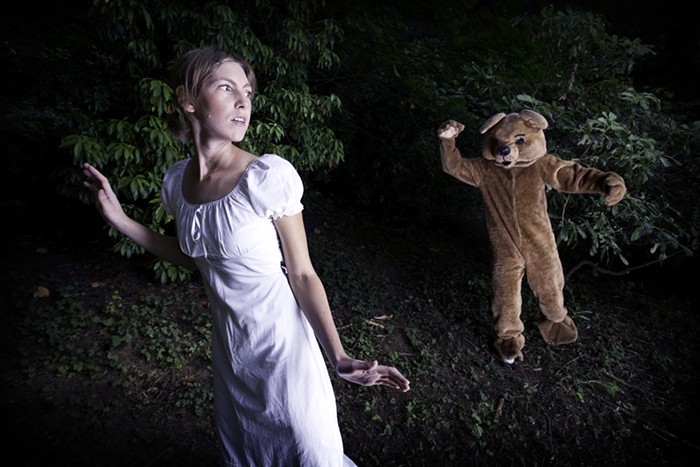Well, our annual revenge has arrived and its name is TBA. Spanning 10 days, PICA's Time-Based Art festival will bring more than 200 artists from around the world to grace our stages, walk our streets, and provide a temporary cure for any lingering sense of civic inferiority. Highlights range from gothic chanteuse Diamanda Galas, to Portland's own faux-lecture-mastermind Andrew Dickson, to a film by quirky Canadian filmmaker Guy Maddin, to the Chekhov-meets-the-Space-Program dance theatre of 33 Fainting Spells. There are also daily noontime chats, workshops, and lectures offered by many of the artists. If all this sounds a little cerebral, Machineworks offers a nightly dose of dancing and food, a full bar and Cabaret Stage entertainment.
Sounds perfect, except for one problem. Unless you possess unlimited free time and an inexhaustible cash flow (tickets for individual events average around 20 bucks a pop), you've got some decisions to make. I suggest calling in sick, wearing all black, and telling people you are from ArtForum. If that fails, here is a roundup of things you just can't afford to miss.
(Advanced purchase of tickets and passes for these events is HIGHLY recommended. Call 242-1419, or visit www.pica.org to get on it!)
No Lifeguard on Duty
Hotel pools are mysterious, sensuous places where reality drifts away and anonymity laps against your weary body. Headlong Dance Theater's co-directors--David Brick, Andrew Simonet and Amy Smith--found themselves lounging in just such a pool somewhere in Tennessee, trying to escape the rigors of a booking conference they were attending. Suddenly, the strange environment sparked an idea: they could hold performances there. Every city in America has a hotel pool. Headlong could embrace the abnormalities and nuances of each site. Frequent musical collaborator Rick Henderson could craft a sound score melding underwater musique concrete and children's echoing laughter with lush pop songs. They could dance in the pool and around it... wearing business suits!
Then they got out of the pool, dried off, got the hell out of Tennessee, and started to make Hotel Pool a reality.
Brick spent many hours researching hotel pools. He watched "hairy, awkward businessmen slide into the pool, close their eyes, and fall playfully into the water." The resulting piece explores the overwhelming kinesthetic power of pools, a force that can transform these burly entrepreneurs into childlike daydreamers. As Brick put it, "No matter how uninspiring a hotel is, the pool--a wet, glimmering thing--can be overwhelmingly beautiful and full of imagination."
In the past, Headlong has crafted experimental dances that have investigated icons of consumer culture, (in Britney's Inferno, the troupe tackled the cruel nature of fame, MTV choreography, and the fickle fancies of starstruck teens), but Hotel Pool is a site-specific event that challenges the very concept of performance. The audience watches from the edge of the humid Hilton hotel pool while an odd narrative unfolds in the sterile water--a businesswoman checks into the hotel, but inexplicably finds herself in the pool instead of her room. It is a familiar space for both the character and the audience, but one that in Headlong's hands possesses a voyeuristic, surreal power.
Hotel Pool plays Thurs-Sun, Sept 16-19, 9 & 11 pm, Portland Hilton Hotel Pool, 921 SW 6th
Celluloid is an Intoxicant
Janie Geiser's short films--collected under the title The Emotional Lives of Inanimate Objects--are always compared with dreams, so before screening her work for the first time I resolved not to use the comparison. I quickly learned it's not possible. Paper cutouts and antique figurines inhabit sets constructed of dollhouses and painted erector sets. Visual leitmotifs pass in and out of the work: clocks, strips of ribbon and text, maps, floral wallpaper patterns and tiny turning gears. Plot points are hinted at, but never resolved. Musical scores incorporate found sounds, muffled voices, and warm, repetitive organs. Geiser describes these elements as "a kind of unearthed hidden narrative which I have attempted to re-piece together, as if these figures were hieroglyphics of a just-forgotten tongue."
The final effect is undeniably dreamlike. Geiser's films are recreations of those déjà-vu moments when something happens--a leaf falls in a certain way or a stranger brushes past your arm--and you realize it happened in a dream. Not last night, probably weeks ago. You can't remember how the dream ended or began, just a few flat visual elements. They seem important but you don't know why. You feel lonely, paranoid, lost. There was a guy in a hat and trench coat. Someone was smoking, or it was foggy out, or you were in a steamy factory. You think someone got hurt. It wasn't you, but someone got hurt. It's hard to breathe. Everything is scary and beautiful at the same time. Everything! And wait, was there a giant deformed baby watching the whole thing?
Then, suddenly, you realize you are just walking down the street. Did you even have that dream, or did you just make it up? Does it matter? You're okay. At least you seem okay. And... roll credits: a film by Janie Geiser.
The Emotional Lives of Inanimate Objects plays Saturday, Sept. 18, 4 pm, Guild Theater
Time is Running Out
With acts pouring into Portland from around the world, it's nice to know some locals can hold their own on an international stage. Under an Hour is the collaborative effort of two Portlanders: choreographer Tahni Holt and painter/installation artist Marty Schnapf. The performance features Holt's dance company, Monster Squad, and an original score by Menomena, which will be performed live by the band. The trilogy takes place over three consecutive nights with each dance lasting less than 20 minutes (don't worry, one ticket gets you into all three shows).
Holt and Schnapf started conceiving of the work more than a year and a half ago. While both saw thematic similarities in each other's work--momentum, conflict, explosions of movement--neither was interested in simply choreographing a dance to be performed in front of some paintings.
The pair began to focus on cross-pollinating genres and mediums, and then Schnapf had an epiphany: "I can do more than make paintings." For Under an Hour, he designed an unconventional stage floor. On the first night, it will hold a an inch of water, on the second night it holds a thin layer of flour. As the dancers leap and spin, the water or flour traces the lines of their momentum out to their final conclusion.
Holt's dances are intricate juxtapositions of physical conflict and dependence. Dancers push and trip each other, cradle each other on the floor, and help each other to their feet. Then it happens again and again. The overall effect is a metaphor for both interpersonal relationships and clashing civilizations. Schnapf says, "Events often lead up to some kind of pinnacle, and there is an hour that changes everything, whether it's a breakup or a nuclear attack." Under an Hour is a frantic, beautiful representation of that all-important moment when something is changed forever.
Under an Hour plays Sept. 11-13 at 4 & 6:30 pm, Machineworks. Each day features a different part of the performance, and your ticket covers all three days.
Karaoke Might Save Your Life
"People see it as a problem when someone just freaks out, not as a thermometer of something deeper in us all," Khaela Maricich (aka the Blow) confided in me. "You must maintain a normal rhythm." The idea of people's rhythms and patterns is important to Maricich--our language, music, even our clothes establish patterns. When we fall out of these patterns, we enter "still, strange places, where dark things happen." We stare for too long, stand motionless in bizarre places and pause at awkward moments. We break down.
Maricich recently moved to Portland from Olympia to take advantage of an artist residency at PICA. In The Touch Me Feeling, she has created a faux corporate presentation for Rem#244sch, a Swiss company that creates personalized karaoke and dance routines that, when performed daily, keep people in step with their natural patterns. She utilizes video and live web conferences with patients, family members, and company executives to sell this unconventional prescription to the public.
Performance art in a pantsuit, The Touch Me Feeling is a subtle, deadpan exploration of collective pain and individual sanity.
The Touch Me Feeling plays Sept. 17-19 at 7 pm, Wieden + Kennedy Atrium












